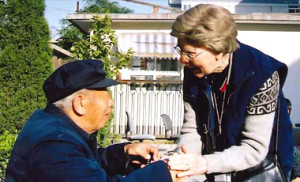From Maryknoll Magazine: Every year on August 15 thousands of Catholics in China make their way up the steep hill in the village of Donglu in Hebei Province to the country’s most popular Marian shrine there. They are remembering the day in 1900 during the anti-Christian Boxer Rebellion when the Virgin Mary and St. Michael the Archangel reportedly appeared in the sky as soldiers were attacking the village and attempting to kill its Christian residents. In fear of the apparition, the soldiers fled and the Christians were saved. The victory was reported on August 15, feast of the Assumption of the Blessed Virgin Mary. It is not surprising that years before Pius XII in 1950 proclaimed the dogma of Mary’s Assumption, Chinese Catholics celebrated the feast.
The declaration of the dogma of Mary’s Assumption into heaven did not surprise most Catholics around the world. It was not a matter for debate, but a moment for rejoicing. For the Catholics at Donglu, the declaration was a confirmation of what they already held dear. Mary, their mother, was very much alive in body and soul. Had she not saved them from the swords of the Boxers? Had they not triumphed repeatedly over those who would destroy their shrine and forbid them from celebrating her feast? Yearly they gathered at her shrine to say “thank you.”
Leaders in the Universal Church were aware that the declaration of the dogma was a teachable moment. It was important for the laity everywhere to understand the meaning of Mary’s Assumption. The declaration was a confirmation of a long held belief that Mary had been taken body and soul into heaven, where she shared in the glory of her son’s resurrection. It was the fulfillment and culmination of her immaculate conception, and what her “yes” to the angel Gabriel could mean for everyone. To the faithful pilgrims of Donglu, who would never forget what she had done for them, she well deserved to be assumed into heaven! No privilege the Church accorded to Mary would ever suffice.
By declaring the dogma of Mary’s Assumption, the Church was making an implicit statement: the human body is holy; it is not only for time but for all eternity. The Assumption signifies that Mary was assumed body and soul into God’s wholeness. Mary has already received what is true for all believers. We, too, will live with God forever. We have it on Jesus’ word: “God so loved the world that he gave his only Son, so that everyone who believes in him might not perish but might have eternal life” (John 3:16).
God entered the world of human beings through a human mother, Mary. By virtue of her life-long openness to all that God asked of her, it was inconceivable to the Church Fathers that her body should be corrupted in the grave. They believed that Mary’s body must already have the eternal quality of the complete human being, that is, one who has achieved full stature in Christ (Ephesians 4:13).
It was not just by coincidence that the pope declared the dogma of Mary’s Assumption on the feast of All Saints. On this feast we celebrate the millions of unknown nameless friends of God, among them surely hundreds who once climbed the steep hill to Donglu to celebrate Our Lady’s feast. Like Mary, they too have “reached their full stature in Christ.” The dogma of the Assumption confirms our hope that death does not end in corruption but in a transformed existence, the likes of which we cannot imagine. Paul told us as much: “Eye has not seen nor ear heard, nor has it entered the human heart to know what God has prepared for those who love him” (1Corinthians 2:9).
The feast of the Assumption is a missionary feast, a feast of Christian hope, a hope that heralds good news to the poor and to all who live peaceably in our global village believing in the promise that Mary’s Assumption is for all people, for all eternity.

